by Marco Maculotti
For the purpose of the continuation of the analysis concerning the foundation myth by the Viracochas [cfr. Viracocha and the myths of the origins: creation of the world, anthropogenesis, foundation myths], it will now be useful to pause to produce some considerations on the importance in the Andean tradition of the ceremonial center of Tiahuanaco, "one of the most significant and disconcerting legacies of human prehistory" [Petratu and Roidinger, p.152], cradle of the first men of the "Fifth Sun" [cf. Pachacuti: cycles of creation and destruction of the world in the Andean tradition]. The origins of this monumental complex are lost in the mists of time: at the time of the conquest the Andes claimed to have never known the city if not in ruins; the Aymara, one of the most ancient peoples of the Andes, claimed that Tiahuanaco had been inhabited "from the first men of the Earth"[Charroux, p.52]. For these reasons, by virtue of its enigmatic nature, Tiahuanaco has always attracted the curiosity of historians and explorers. In 1876 the French archaeologist Wiener wrote [cit. in Charroux p.49]:
"A day will come when it will be possible to say about the classical civilization of the Pharaohs, the Chaldeans, the Brahmans: you are cataloged in our books as the most ancient, but science proves that the pre-Inca civilization of Tiahuanaco precedes yours by many thousands years. "
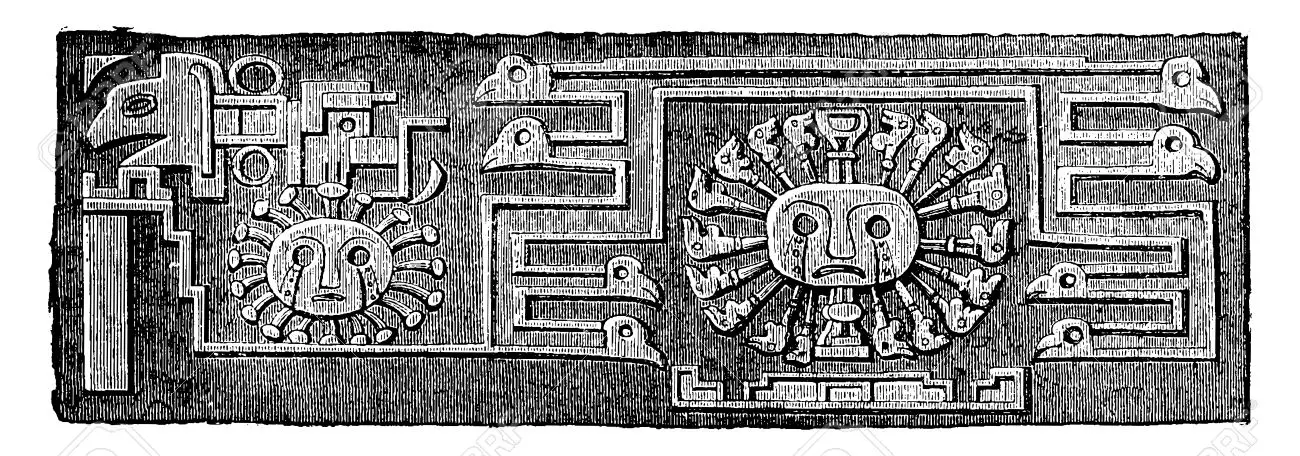
The builders of Tiahuanaco
 As early as the XNUMXth century, Cieza de León considered it the oldest sacred site in Peru, long before the Inca empire. Leon himself was able to question the natives, and asked them if such structures had been built in the time of the Incas. In response, the natives laughed at him, repeating what they had already explained to him earlier, namely that long before the Incas reigned, such sites had already been erected. It was not possible to say with certainty who the builders of Tiahuanaco were, but the natives, recalling the stories of their ancestors, told León that, according to the myth, these megalithic structures were seen appearing one morning, out of nowhere. Ancient chronicles reported by León put this prodigy in connection with a mysterious race of "bearded men", who were seen at that time on the islands of Lake Titicaca, on the shores of which Tiahuanaco is believed to have stood in ancient times. According to a better known interpretation, Tiahuanaco in ancient times was not only on the shores of the lake, but also inside it: according to this theory, the ceremonial site therefore stood on an island within the lake ("The island of the Sun" of the myths of the origins), which in that primeval age was assumed to be much larger than it appears today. In any case, according to the mythical narratives reported by Cieza de Léon, the same men would also have erected Vinaque (a monumental complex believed today to date back to the pre-Inca civilization Wari) [Macedo, p.10]. According to the testimonies of the natives, this mysterious race of "white bearded men (...) arrived there long before the Incas, they founded a settlement "near Huamanga, where very ancient ruins can still be seen today, testifying to the enormous buildings described by León; they were called in the Quechua language atumu rune, which Jacques de Mahieu derives from hatun rune ("White men") or even more correctly from atuma rune ("Moon-faced men") ... in short: "pale faces"[Drioli, p.108].
As early as the XNUMXth century, Cieza de León considered it the oldest sacred site in Peru, long before the Inca empire. Leon himself was able to question the natives, and asked them if such structures had been built in the time of the Incas. In response, the natives laughed at him, repeating what they had already explained to him earlier, namely that long before the Incas reigned, such sites had already been erected. It was not possible to say with certainty who the builders of Tiahuanaco were, but the natives, recalling the stories of their ancestors, told León that, according to the myth, these megalithic structures were seen appearing one morning, out of nowhere. Ancient chronicles reported by León put this prodigy in connection with a mysterious race of "bearded men", who were seen at that time on the islands of Lake Titicaca, on the shores of which Tiahuanaco is believed to have stood in ancient times. According to a better known interpretation, Tiahuanaco in ancient times was not only on the shores of the lake, but also inside it: according to this theory, the ceremonial site therefore stood on an island within the lake ("The island of the Sun" of the myths of the origins), which in that primeval age was assumed to be much larger than it appears today. In any case, according to the mythical narratives reported by Cieza de Léon, the same men would also have erected Vinaque (a monumental complex believed today to date back to the pre-Inca civilization Wari) [Macedo, p.10]. According to the testimonies of the natives, this mysterious race of "white bearded men (...) arrived there long before the Incas, they founded a settlement "near Huamanga, where very ancient ruins can still be seen today, testifying to the enormous buildings described by León; they were called in the Quechua language atumu rune, which Jacques de Mahieu derives from hatun rune ("White men") or even more correctly from atuma rune ("Moon-faced men") ... in short: "pale faces"[Drioli, p.108].
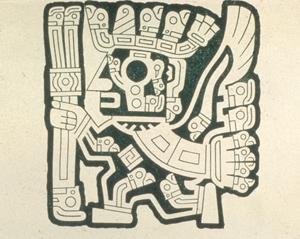 Such mysterious bearded men seem to be related to the legendary Viracocha - mythical cultural hero who civilized primitive humanity in very remote times -, and with the messengers that Viracocha sent from Lake Titicaca in the myth of the foundation of the four spaces of the Tahuantinsuyu [cf. Viracocha and the myths of the origins: creation of the world, anthropogenesis, foundation myths]: to the point that the Spaniards on their arrival were mistaken, due to their physical characteristics, for the sons of the creator god, and therefore were generically called - also by virtue of the prophetic dream of the historical Viracocha, eighth ruler of the Tahuantinsuyu- “viracochas”. These enigmatic men also appear in the tales of Sarmiento de Gamboa and Ondogarde: they would have appeared on the shores of Lake Titicaca, "where they would have built a great city" ["so large and mighty that - according to the Indians - only white giants would have been able to build it, a thousand years before the Incas"] And educated the indigenous to higher forms of culture" [Honoré p.9]. Other legends, while admitting the intervention of the giants, "affirm that they would not have spontaneously submitted to the thankless toil, but would have been forced by creatures from the sky" [Kolosimo, p.250], who would help young humanity against the monstrous titans. THE builders of Tiahuanaco would therefore be, according to the myth, giants, but the architects would they be of another race, "come from heaven": the Viracochas, the mysterious white and bearded men who lived on the Island of the Sun inside Lake Titicaca?
Such mysterious bearded men seem to be related to the legendary Viracocha - mythical cultural hero who civilized primitive humanity in very remote times -, and with the messengers that Viracocha sent from Lake Titicaca in the myth of the foundation of the four spaces of the Tahuantinsuyu [cf. Viracocha and the myths of the origins: creation of the world, anthropogenesis, foundation myths]: to the point that the Spaniards on their arrival were mistaken, due to their physical characteristics, for the sons of the creator god, and therefore were generically called - also by virtue of the prophetic dream of the historical Viracocha, eighth ruler of the Tahuantinsuyu- “viracochas”. These enigmatic men also appear in the tales of Sarmiento de Gamboa and Ondogarde: they would have appeared on the shores of Lake Titicaca, "where they would have built a great city" ["so large and mighty that - according to the Indians - only white giants would have been able to build it, a thousand years before the Incas"] And educated the indigenous to higher forms of culture" [Honoré p.9]. Other legends, while admitting the intervention of the giants, "affirm that they would not have spontaneously submitted to the thankless toil, but would have been forced by creatures from the sky" [Kolosimo, p.250], who would help young humanity against the monstrous titans. THE builders of Tiahuanaco would therefore be, according to the myth, giants, but the architects would they be of another race, "come from heaven": the Viracochas, the mysterious white and bearded men who lived on the Island of the Sun inside Lake Titicaca?
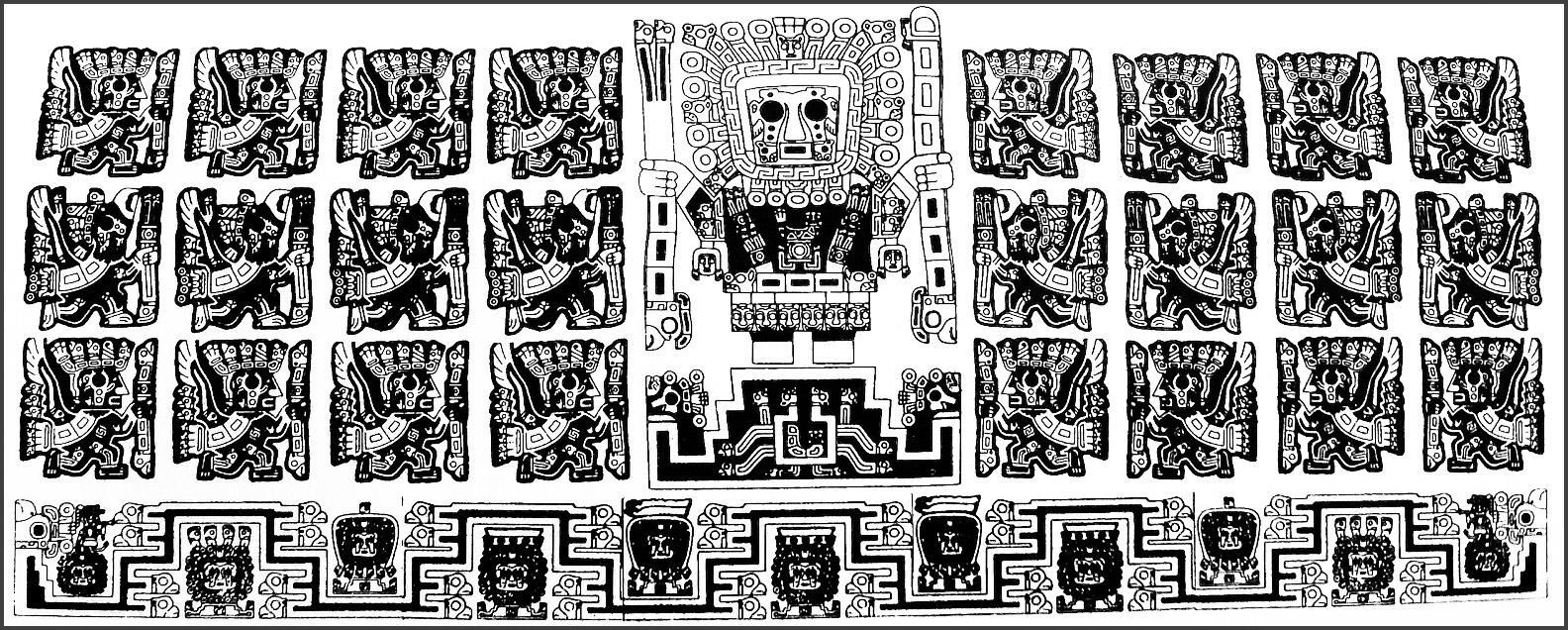
The monoliths of the giants
In more recent times, the followers of Hans Hörbiger [cf. Hans Hörbiger: The Cosmic Ice Theory], the best known of which are Saurat and Bellamy, recognized Tiahuanaco as the ancient cradle of humanity, forged by forgotten hands of humanity. As Pauwels and Bergier write [Pauwels and Bergier, pp. 311-2]:
“Bellamy notices in the Andes, at four thousand meters, traces of marine sediments that extend for seven hundred kilometers. The waters of the tertiary end reach up there, and one of the centers of civilization of this period would be Tiahuanaco, near Lake Titicaca. The ruins of Tiahuanaco testify to a civilization hundreds of times millennial, and which bears no resemblance to later civilizations. For the followers of Hörbiger, the traces of the giants are visible there as their inexplicable monuments (...) Everything invites the followers of Hörbiger to see in these statues portraits of giants they made themselves."
According to the two French authors, "If those monoliths were sculpted by giants for their disciples, men" and "if the sculptures of extreme abstractness, of a stylization so strong as to confuse our intelligence, were made by those Superiors, we find in them the origin of the myths according to which the arts were taught to men by gods". Certainly the “magical realism” of Pauwels and Bergier must be taken with a grain of salt; yet the same Garcilaso Inca de la Vega, in his excursus on Tiahuanaco in book III of the Royal Commentaries, after describing with great astonishment the cyclopean dimensions and the amazing technology of its builders [Garcilaso, book III, p.94], finally admitted that he was not able to explain how this construction took place, nor with what tools ("these are questions we cannot answer").
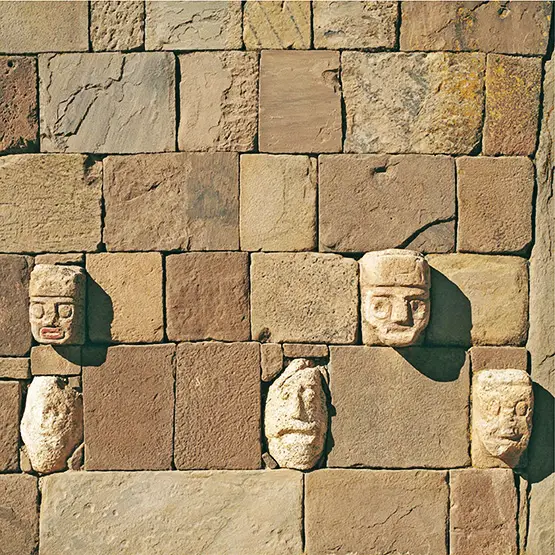
The myth of the stoning of the traveler
Garcilaso reports also another story about Tiahuanaco [Garcilaso, book III, p.95]: a testimony of Diego de Alcobasa, a childhood friend of his, who later became a priest, to whom the natives told that the site was built in honor of Viracocha, creator of the universe. “In this place - the testimony continues -, there are a large number of anthropomorphic statues, sculpted in such a natural way as to seem alive. Some represent drunks, others are in the attitude of wading a stream, women offering their breasts to their children ... Indians claim that all these statues were once living beings, which Viracocha transformed into stone statues for throwing stones at a traveler". This story, as it is easy to see, is connected to the original myth - already analyzed - reported by Juan de Betanzos, according to which Viracocha, before the creation of present humanity, destroyed the previous one with a flood and - in fact - transforming the survivors into stone statues.
But it also connects, regarding the topos of stoning of the wayfarer, to a myth reported by Cieza de León, according to which [Urton p.38] one of the three (messengers / emanations of) Viracocha (ConTiki Viracocha) "who looked like a tall, white-skinned man" made a northeastern journey from Lake Titicaca "healing the sick and restoring sight to the blind with the power of the word alone "; however, when he arrived in a village called Cacha, south-east of Qosqo, he was greeted by a shower of stones thrown by its inhabitants (almost a parallel of the Homeric meeting of Ulysses with the giants Lestrigoni, who instead of welcoming him as a guest destroyed the his fleet with stones!). Viracocha, in response, rained fire from the sky until an entire area of desert was transformed into glowing rock - a sort of "Sodom and Gomorrah" atlantic. Betanzos wrote that he personally went to Cacha in order to investigate the mythical incident and found there a large area that gave credence to what is told by tradition. Following the incident, on the place, which has now become huaca (because the space and material seat of the divine manifestation), the surviving natives erected a statue of Viracocha which they thus began to worship, offering her gold and silver. It is here to underline how Viracocha, during his mythical wanderings, often adopts the appearance of a beggar, and for this reason he is not recognized by the populations he meets who go, punctually, to meet a sort of divine punishment, such as flood rain. or fiery meteors hurled down from the sky. In chap. 2 of the manuscript of Huaru Chiri it is read:
"In very ancient times Cuniraya went around assuming the appearance of a very poor man, with the yacolla , cousma to shreds. Men, more often than not, did not recognize him and murmured at the sight of him: "Lousy beggar". Yet it was he who animated all the communities and with just one word he created fertile fields and terraces well protected by low walls. "
In another myth, contained in the same manuscript, it is Pariacaca, who as we have seen is a 'son' or an 'emanation' of Cuniraya Huiracocha, who wanders in the guise of the sick beggar. In chap. 25 you can read about his arrival at the community of the Hills: none of the inhabitants offered him a drink, except one:
"Then Pariacaca said to him," Brother, when I come back here you will have to cling to that tree. Don't say anything to the others! " (…) After five days a great wind began to blow which dragged those hills away, very far away, not before having made them whirl two or three times. Some lost their bearings and died; others, however, were transported alive to the mountain located near Carhuayllu. This mountain, still today, is called Colli. It is said that these men all died and none remained alive. Only the man from Yarutini who had offered a drink to Pariacaca was saved ”.
According to other versions of the myth, narrated in chap. 26 of the manuscript of Huaru Chiri, Pariacaca retaliated by transforming himself into "red and yellow rain" (in all probability, a rain of fire), or "frozen them and turned them all to stone". A further version, intermediate to the last two reported, says that the inhabitants of the community "were hit by a red rain and suddenly turned into stone".
Before moving on, it should be noted how the topos of the god who assumes the features of a traveler / beggar is, in the opinion of Lévi-Strauss, universal: he wrote [cit. in Rosati, p.45] that "the myths relating to a supernatural character who tests the generosity of humans in the guise of an old man, a sick person or a needy one, are known throughout the New World". And, we add, not only: think, for example, of the continuous use of such a transformation by Odin / Wotan in Northern European mythology. And during these wanderings Cuniraya Viracocha, just like Odin, sometimes impregnates his favorites: as happens with a beautiful woman called Cahuillaca, "who was a huaca and she was still a virgin "[Huaru Chiri, chap. 2], made pregnant with a subterfuge worthy of Zeus: Cuniraya transformed into a bird and introduced her seed into a fruit of lucuma, which he then dropped next to the woman who, eating it, immediately became pregnant.
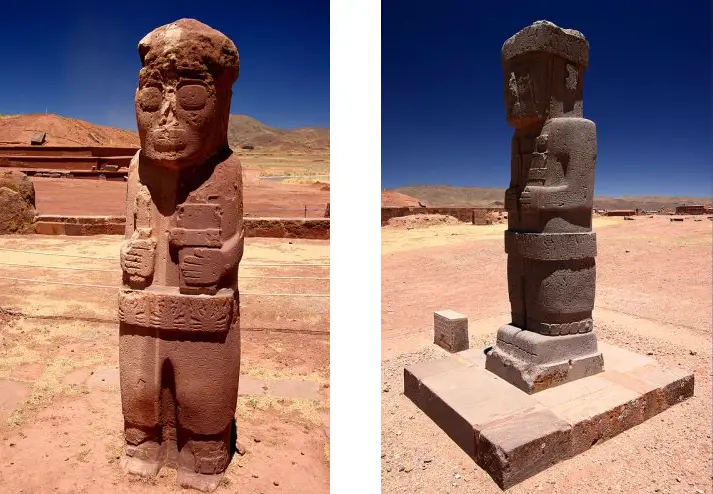
An underground city?
Another testimony comes to us from a manuscript by Gonzales de la Rosa, a transcript of the statements of quipocamayo (interpreter of quipas incas) Catari, who translated for the Jesuits the secret language of the enigmatic knotted cords. In 1625 the manuscript was donated by the Jesuits to the Vatican, which would still keep it in the Library. Here is the summary of the part that interests us of this manuscript, quoted by Charroux [Charroux, pp. 56-7]:
“The primitive name of Tiahuanaco was Chucara. The city was entirely underground and what existed on the surface was only the stone cutting site and the workers' village. The underground city could provide us with the key to an amazing civilization that dates back to the most remote times (...) Near Lake Titicaca there was a palace of which no trace remains since it would have been built, according to the texts, at the time of the «Construction of the world". The first lord of Chucara, which means "Abode of the Sun", was called Huyustus; he had divided the globe into various realms (…) In Tiahuanaco the lying dead were buried. A white bearded race lived on the islands of the lake. "
Here is the reappearance of the name Hyustus, whom we have already met as "the deified hero, who came from the sea or rose from the waters, who created everything and issued wise laws", the one the Aymara described as “blond and blue-eyed”: the “White God" of pre-Columbian traditions. Its identity is therefore confirmed with the cd. "Creator of Tiahuanaco", the legendary Viracocha who "had divided the globe into various realms" or, as they say in other narratives, divided the territory into four parts, creating the Tahuantinsuyu original [cfr. Viracocha and the myths of the origins: creation of the world, anthropogenesis, foundation myths].

Recent hypotheses
Some, more recently, have argued that the ancient name of Titicaca was Chukahua and they emphasized the similarity with the Gothic skuggwa-uod ("Mirror water" or "mirror of water") [Drioli, p.118], assuming that the founders of Tiahuanaco were Viking settlers who had come to Peru in ancient times. This, if on the one hand raises considerable doubts - especially as regards the dating of Tiahuanaco and its architecture, which the Viking populations could never have completed, since they used to build their temples mainly in wood - on the other hand it brings us back to what Cieza de León reported about the mysterious race of white and bearded men who were seen at the time of the construction of the site of Tiahuanaco on the Titicaca islands, and whom we have recognized to be the messengers of Hyustus / Viracocha, the "creator of Tiahuanaco".
Others [Honoré, p.189] they theorized that the "white gods" of ancient America may have been the Olmecs, a somewhat enigmatic civilization of which not much has come down to us, apart from a series of cyclopean sculpted heads with Caucasian and Negroid features, but not Amerindians. Still others see in the enigmatic Toltecs the mythical initiators of all Amerindian cultures. However, in the opinion of other scholars, the Tiahuanaco civilization is much older than the historical era in which the Vikings lived. Olmecs and Toltecs: it is hypothesized that it was born many thousands of years before the academic hypotheses, which want it to date back to at most 1.000 BC Petratu and Roidinger, supporters of this theory, write [Petratu and Roidinger, p.153]:
“Since that time, the climate and vegetation of the place have not essentially changed. Why, then, would a city have to be built four thousand meters high with megaliths weighing tons, if the environment could not support its inhabitants? It is evident that none of the resident Indian tribes, who had lived there thousands of years before the arrival of the Spaniards, supported the city. When they settled here, they found a dead and abandoned city. Consequently they thought that it could not be a human work. Such a gigantic city could only be attributed to a long-extinct race of giants. "

A sudden disappearance
Among the few certainties about the mysterious civilization of Tiahuanaco, there is the fact that it disappeared as suddenly as inexplicably, many centuries or even millennia before the Inca empire. According to the archaeologist and researcher Klaus Dona to designate the fatal moment of the culture of Tiahuanaco were the violent earthquakes, following the impact of a meteorite body in Argentina, which occurred four thousand years ago. By means of the catastrophe the sites of Tiahuanaco - which at the time was a port (or an island) on Titicaca - and Puma Punku were pushed to four thousand meters high, in the most solitary deserts, the only survivors, silent witnesses of the past greatness.
According to another popular theory, the white builders of Tiahuanaco would have been defeated by a tribe headed by a cacique Araucan named Cari or Kari, coming from the Coquimbo region, in present-day Chile. Even today, among the Amerindians of the Bolivian plateau, the name Cari is synonymous with "Evil", confirming what Montesinos wrote centuries ago: the defeat of the civilization of Tiahuanaco was such a disgrace that the natives began to use the word Dear to indicate all that is bad or that indicates bad luck. Bolivian legends collected by Cynthia Fain, which would date back to more than five thousand years ago (and therefore would backdate the facts to before 3.000 BC), tell [Pauwels and Bergier, p.207] that the civilization of Tiahuanaco vanished "after a conflict with a non-human race whose blood was not red". The inhabitants of the Uros floating islands, in Lake Titicaca, trace the origins of their race back to a primeval time, when Lake Titicaca was more extensive than it is today and there was no moon in the sky. They told the ethnologist Jean Vellard [cit. in Petratu and Roidinger, p.156] as follows:
“We, the others, we the inhabitants of the lake, the Kot-Sun - we are not men. We were there before the Incas, and even before the Father of Heaven, Tatiu, had created men, the Aymarà, the Quechua, the whites, we were there. We were even there before the sun began to illuminate the Earth. Since the days when the Earth was still shrouded in semi-darkness, when only the sun and the stars illuminated it. When Lake Titicaca was much larger than it is today. Even then our fathers lived here. No, we are not men. Our blood is black, so we can't freeze to death, we don't feel the cold of lake nights. We do not speak any human languages and men do not understand what we are saying. Our heads are different from those of other Indians. We are very old, the oldest. We are the inhabitants of the lake, the Kot-Sun. We are not men! ".
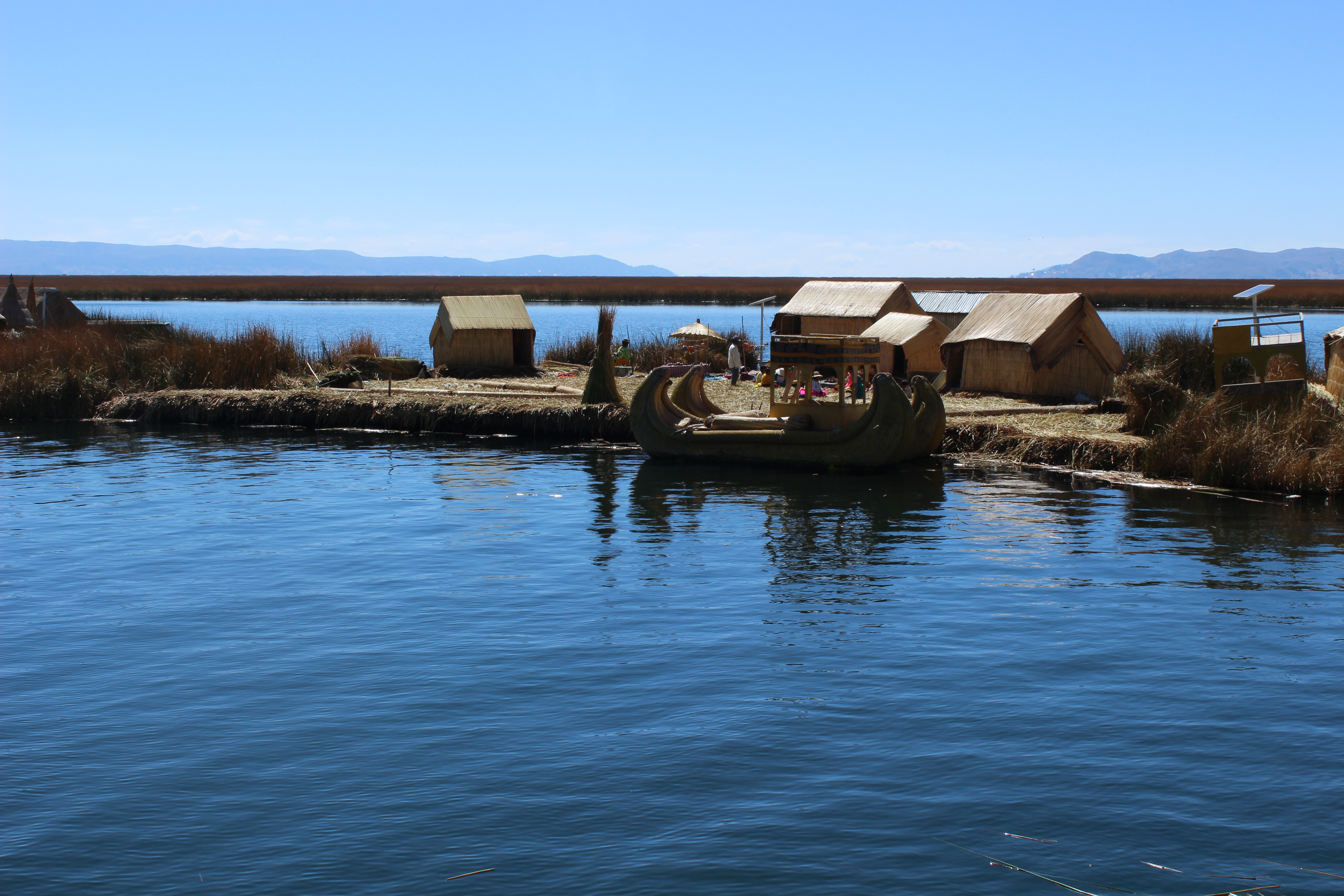
bibliografia:
- Robert Charroux, Unknown history of men (Ceschina, Milan, 1966).
- Gianfranco Drioli, Ahnenerbe (Ritter, Milan, 2011).
- Pierre Honore, I found the white god (Garzanti, Milan, 1963).
- Peter Kolosimo, Timeless land (Sugar, 1969).
- Garcilaso Inca de la Vega, The Royal Commentaries of the Inca (El Lector, Arequipa, 2008).
- Justo Cáceres Macedo, Prehispanic Cultures of Peru (Lima, 2009).
- Louis Pauwels and Jacques Bergier, The morning of the wizards (Mondadori, Verona, 1971).
- Cornelia Petratu and Bernard Roidinger, The stones of Ica (Mediterranee, Rome, 1996).
- Liliana Rosati, The true story of Huaru Chiri (Sellerio, Palermo, 2002).
- Gary Urton, Inca myths (British Museum Press, London, 1999).

http://press.nationalgeographic.com/2013/09/11/uros-people-peru-bolivia-distinctive-genetic-ancestries/
https://arcodabara.wordpress.com/2015/04/17/the-ancient-giants-of-the-new-world/